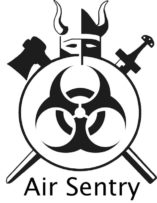Airsentry® was evolved to deal with disease situations such as Sars-Cov-2.
Initially from 2003, the system has been gradually fine tuned alongside UK hospital clients, with specific model and design changes occurring in 2006 and 2009.
Airsentry® is in use for staff and patient protection in relation to coronavirus.
We’ve used an ICU with a lobby area, negative pressure and ceiling mounted grills for air changes as an example below. With ventilated patients the core risk is around CPR and Intubation as filters will be applied to ventilator exhaust outlets.

Good PPE is essential in this environment. If the room design has high level air intake and low level extract, so that the room airflow runs diagonally across the room from ceiling to floor, away from the door, the staff risk and egress risk is low. The room must be negatively pressured to prevent egress.
Most ICU rooms in the UK do not follow this design. Whilst there is access to negative pressure isolation, staff mistakenly think this protects them, it doesn’t. It only prevents pathogen egress into the general ward area. Instead the air intake is mounted in the ceiling and the air extract also. Staff may believe they are achieving 16 or 25 air changes an hour but this has been based on airflow across the ceiling. In reality the room air changes may be far lower and in the room corners may not be changing at all.
Staff working in this environment are under constant pressure and there is no failsafe. If a mask leaks or an error occurs, even an adjustment to clear sweat, they increase the risk of contracting Sars-cov-2.

Airsentry® decreases both the risk and the staff pressure exponentially.
It assures a high level of air cleanliness, ultra clean (near sterile) by producing a whole room air current. This air is continuously cycled through our EN14644 part 3 bespoke filtration system which removes all particles, including coronavirus, at 0.3um or greater, with an efficiency of 99.99998%,
We can supply a clients letter in relation to the effect this has on infection control and also staff morale to accredited NHS email addresses upon request.
From a staff perspective, the system is simple, once turned on it just works quietly and it is unobtrusive. It is designed to pull the dirty air at a low level, remove nearly everything, and then return it over the patient area. The dilution effect achieved in an ICU area is equivalent to around 80 air changes an hour, without the noise or large drafts.
Power consumption is low, around 100w and the filtration is designed for a two year expected life, in a healthcare setting.
